 |
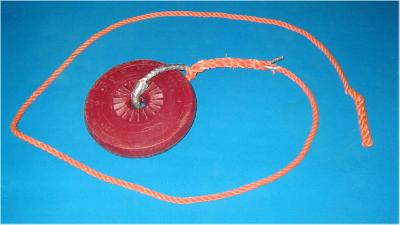 |
| Volley Ball | Weighted Line |
Pool Toys & Games
by
Larry "Harris" Taylor, Ph.D.
This material is copyrighted and the author retains all rights. This article is made available as a service to the diving community by the author and may be distributed for any non-commercial or Not-For-Profit use.
All rights reserved.
Go To: Home About "Harris" Articles Slides War Stories Editorials Links Fini
Jump To: Treading Object Retrieval Sonic Search Golf balls The Rocket Black Mask Board Games
Mirror Tower Nuts & Bolts Hula-Hoops Pirate-Hoops Lift Bags Talking Cannon
PVC Pipe Puzzle Type: Half-inch 1.5" (Red) 1.5" (yellow) 2" (yellow) 2" (green) 4" (green)
A novice dive class is really a class in behavioral modification. We need to convert people, land dwelling animals, into under-water-comfortable divers. To do this, we need to introduce a new set of instincts and behaviors to not only ensure survival, but to convey the most important concept that immersion in Planet Ocean, once basic skills are developed, can be an indescribably wonderful experience. (See The Primitive Brain ) Educators have known for centuries that "fun & games" enhances learning. So, as an instructor, I often visit toy stores looking for additions to my collection of teaching toys. I typically end every basic class with about 10 minutes of "play time." ... the bottom of the pool has an assortment of toys that change as the class progresses. Play time and toys give students a chance to independently reinforce learned skills, succeed in problem solving and develop underwater eye-hand co-ordination in an environment that is more fun than a formal exercise. This article describes my teaching arsenal of toys.
Treading
The first pool session sets the tone for the entire class. It is a time when both students and staff evaluate each other. One of the most boring first session exercises is treading water for 20 minutes. To help pass the time, we use a volley ball. The students tread water in a circle. so that everyone is visible. Then the students and staff toss the volley ball around the circle. However, every time the volley ball is caught, the person catching the ball must answer (so that all can hear) the "question-of-the-moment." Once everyone has answered the question, we ask another. This cycle is repeated until the time has expired. The questions are: name, reason for the taking class, where do you want to dive, most beautiful sea critter, biggest fear of taking class, what is the most dangerous sea critter (after all have answered, I point out that the lowly sea urchin probably causes more diver injury than any other critter), occupation or school major, favorite movie, favorite book, favorite TV show, favorite song, etc.) We also, near the end of the allotted time, add a line with a weight on the end of it ... this typically goes around the circle twice ... the first time, the recipient states their name; the second time, the person with the weight must name the person to whom they are passing the weight. The weight cannot be passed until the required name is verbalized.
The idea is not only to kill time, but to start the process of thinking while "doing stuff" in-water
 |
 |
| Volley Ball | Weighted Line |
Surface diving techniques are more fun to learn when there is some object to retrieve from the bottom of the pool. Although scuba weight-belt lead (plastic coated to protect the pool) can be used, below are objects typically sold as pool toys that can be used as objects to be retrieved. The coins (each about 2.5" in diameter) are often found in novelty stores or museum shops.
|
|
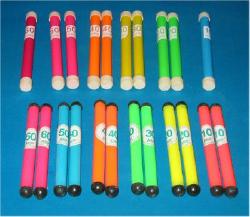 |
 |
|
Clams |
Rods |
Circles |
 |
 |
|
Coins |
Sonic Search |
Another object to retrieve is a toy called the "Sonic Search." It is a small sphere that emits an electronic ping (sounds like the changing tones of an auditory function test) for 60 seconds after submersion. The goal is to find the object before it stops pinging.
The first session on scuba ends with an opportunity to "juggle" golf balls, It sets the tone for much of my method of teaching in that the typical student's first response (as a "land dweller") is "I can't do this!" But, most folks can easily juggle three ...sometimes four or five golf balls underwater because the density of the water dramatically slows the downward path. So, in doing this first challenge, the students begin to appreciate the differences between underwater and on-land perceptions. More importantly, they leave the very first scuba session having accomplished something they, most likely, believed to be impossible (and they will return for even more successes!)
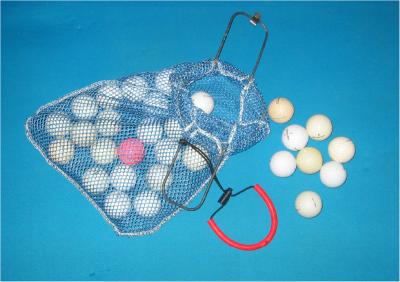 |
Note the goody bag ... nearly all my toys and puzzles are in goody bags. This not only facilitates transport and storage, but adds another task for the student.
Also, many of my puzzles are used in open-water and the bag/wrist lanyard aids in control of the puzzle pieces.
These golf balls are being recycled: they all were found on various Michigan inland lake bottoms. |
|
Golf Balls |
This is another water-is-different experience. This is a weighted pool toy (about a foot ; 30 cm long) that flies surprisingly well under water.
A smaller version is available as a "five-pack." Students, moved to the side of the pool to prevent hitting some one, play "catch" with the rocket. Other games include throw for longest distance or throw through a suspended underwater loop.
"Shape Toys"
There are a variety of "shape toys." These are used to help kids learn shape recognition. They work well underwater. The object is to place the appropriate piece through a shape-matched opening into the center of the toy. Most of the individual pieces are buoyant. I added a bit of epoxy putty inside each piece to give them weight.
 |
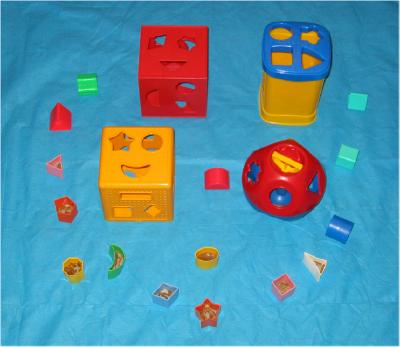 |
|
The "Rocket" |
"Shape" Toys |
This is the traditional low-vis training aid. I covered an old mask with duct tape to prevent any light from entering the mask. Alternatively, people can place pieces cut from a plastic garbage bag into their mask. The object of this exercise is to perform some tactile-based exercise (like the Shape Toys") without visual sensory input.
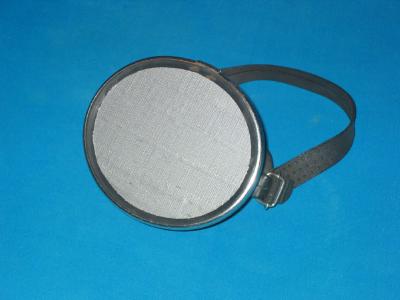 |
Duct tape over any mask will prevent light entry.
This forces diver to rely on non-visual clues. |
|
Black Mask |
A 2 foot (60 cm) square piece of Plexiglas makes a good base for a board game. I simply drilled 2 holes for a carrying handle and used black electrician's tape to mark the squares. The playing pieces are hockey pucks (which, by themselves, can be used for underwater hockey or as objects to be retrieved during surface diving exercises). marked with colored electrician's tape and a permanent marker. (Although best used on scuba, the tic-tac-toe game can also be played from the surface. This requires a surface dive prior to adding the appropriate piece. Divers alternate placing pieces on the board ...this reinforces the skin diving practice of only one buddy submerges while the partner watches from the surface.)
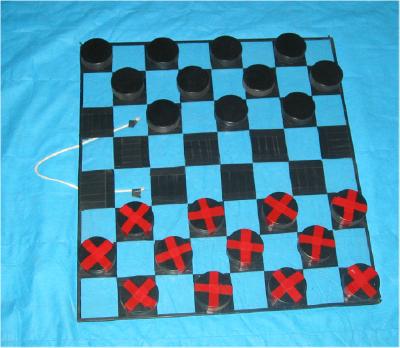 |
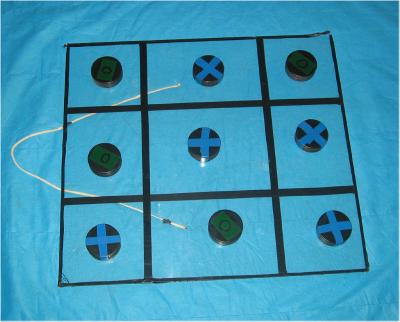 |
|
Checkers |
Tic-Tac-Toe |
After several pool sessions on scuba, I hang a camper's steel mirror underneath a scuba "sausage" emergency float. I tell the students that beneath the float is a magical device. If they look deeply into the universe shown by the magical device, they will see a diver.
 |
I added a 3 foot cord to the steel camper's mirror.
It hangs below a floating scuba "sausage." |
|
Mirror |
This adds a bit of a twist. The tower and its pieces are buoyant. There are two 2-pound weights in the goody bag, so it will sink. The wise student will invert the tower, so the pieces will stay on the tower during assembly.
 |
 |
|
The "Tower" Puzzle |
Solved "Tower" |
This is another buoyant toy. There is a 2-pound weights in the goody bag so it will sink. The object is to thread the bolt or screw through the holes in the straight pieces of plastic. The straight pieces can be bolted together to form a variety of geometric shapes.
 |
Although tools are furnished, the screws and bolts can be secured without them. |
|
"Nuts & Bolts" |
I have four hula-hoops, each with a different length of line between the hoop and the vinyl-coated weight. For convenience, the line has two eye splices: one at either end, with the hula hoop through one of the eyes. The weights have small lines ending with an eye-splice ... a small snap connector is used to attach the weight to the hula hoop. The hula hoops are suspended vertically in the water. Swimming through the hoops begins to build spatial orientation and an awareness of volume occupied. It also has a side benefit of encouraging streamlining to prevent straps and hoses from entanglement. I have also noticed that even with only one hoop in the deep end of the pool, student-hoop collisions are inevitable. Hula hoops are superb, non-threatening obstacles used in the later stages of training (for example, I believe the most difficult exercise our students do is buddy-breathing ...donor has only one fin; recipient has no mask and the buddy team must eventually swim through the hula-hoop while maintaining the sharing of regulators (the hoops are too narrow to allow side-by-side passage) We do this exercise both with secondary air supply and with simulated single regulator exchange. Reminder .... this is NOT done until after about 24 hours of in-water training with a couple of weeks of buddy breathing practice before this is attempted. This "buddy-breathing exercise" is the final stage of weeks of preparation that begins with the first lap around the pool with no mask.)
I also have one hula hoop with three weighted lines. This is set up such that the hula hoop floats horizontally in the water.
I typically start with only one hula hoop in the water and as class progresses, add one at a time until there are 5 in the water. The horizontal floating hoop is the last hoop to be added.
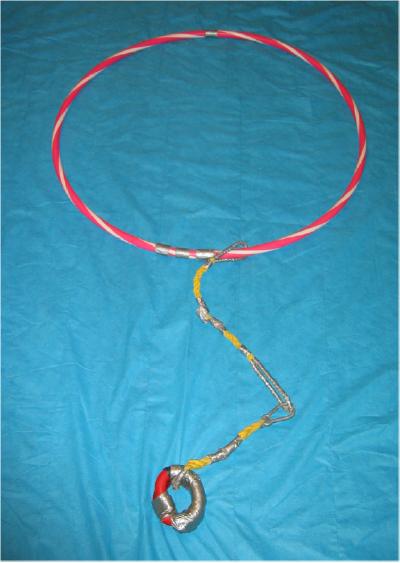 |
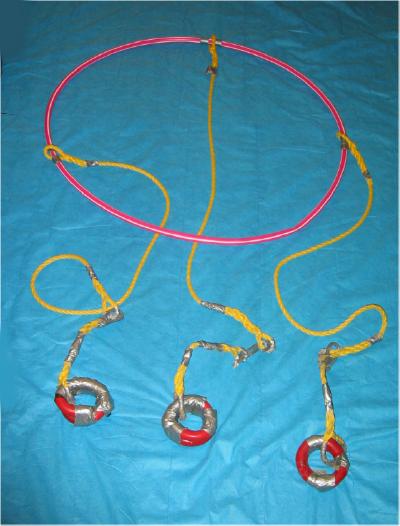 |
|
Hula Hoop (floats vertically) |
Hula Hoop (floats horizontally) |
These are small (~ 25" in diameter) spring-loaded self-opening hoops (3 per package). They contain their own weights (on the bottom) and buoyancy (on the top). When deployed, each of the 25" loops will float vertically on the bottom of the pool. So, like hula hoops, these rings provide another "swim-through" training aid that assists students in learning about the volume they occupy when swimming in the water. If entanglement does occur, the light weight of the hoops does not significantly impede an ascent to the surface.
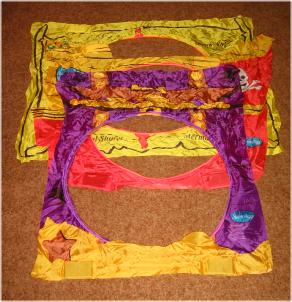 |
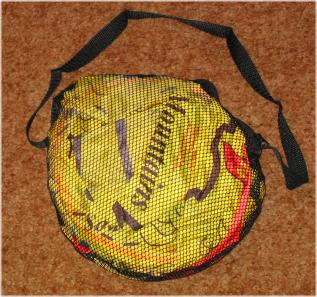 |
| The Three Hoops | Folded For Storage |
I attach a small weight (8 pound vinyl covered anchor recovered from the bottom of a Michigan Lake) to a 40 pound lift bag. The connection is done with a locking carabineer to minimize chances of separation. Locking carabineers provide fast, efficient and reliable connectors, especially in open water where cold, gloved hands are a bit clumsy. This arrangement (left, below) can be used with a snorkel in two ways: individuals can repeatedly surface dive down to the lift bag and exhale through their snorkel into the bag. (Snorkels without valves work the best.) The surface dive, exhale through snorkel into the bag, return to surface for another breath cycle is repeated until the bag lifts the anchor. Alternatively, the lifting operation can be run as a relay (one bag/weight per team) as a relay event. Students should be cautioned that return of the bag/weight (by inverting the lift bag and dumping the on-board air) should be done slowly and carefully to avoid ear equalization problems on descent. On the last night of class, I add a small pony bottle and an air inflation gun (see Liftbags & Life) so the students can do a simple lift.
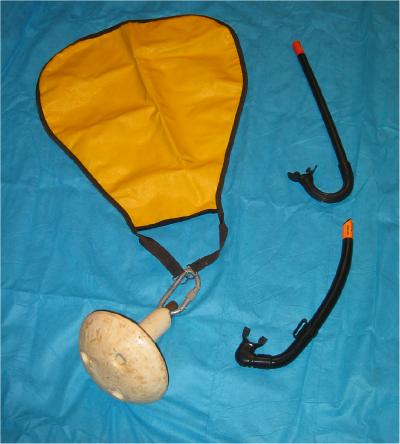 |
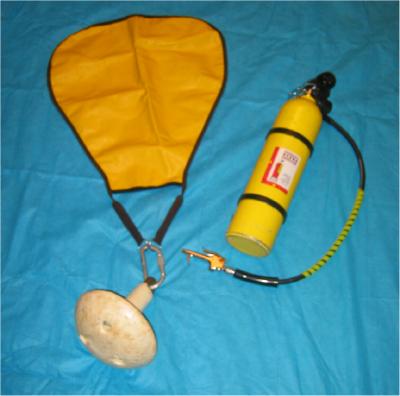 |
|
Lift Bag Set-up For Snorkel Lifting |
Lift Bag Set-up For Air-Assisted Lifting |
The primary component for talking underwater is an air space. Practically anything that provides an air space immediately in front of the mouth can be used for crude vocal communication over short distances. The scuba mask held immediately in front of the mouth can provide such a space. Additionally, there are commercial products that provide this air space. Below left is a product from several decades ago called the Sea Voice. This is a mouth piece and an inflatable latex bladder. Speaking is accomplished by removing the scuba regulator, exhaling into the Sea Voice to inflate the air bladder, and then speaking slowly into the inflated bladder. Below right is something I got from a Hot Tub supply store. It is called a Water Talkie. Again, once the water is removed by exhaling into the device (It has one way exhaust valves to assist this process.), speaking slowly into the trapped air chamber will allow voice communication to a range of about 15 feet.
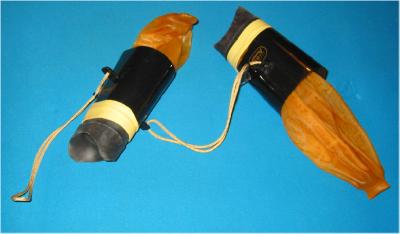 |
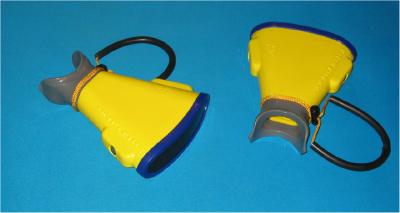 |
|
Sea Voice |
Water Talkie |
This is a simply cone with handles, but when rapidly submerged, it will shoot a column of water up to 30 feet.
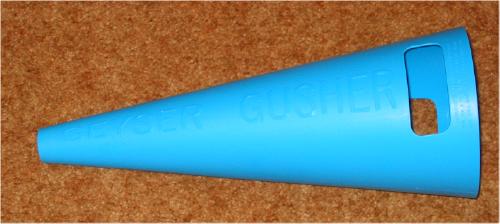
There are all sorts of battery-powered toys that can add ambience to pool diving. Simply place the fish underwater and they will start swimming.
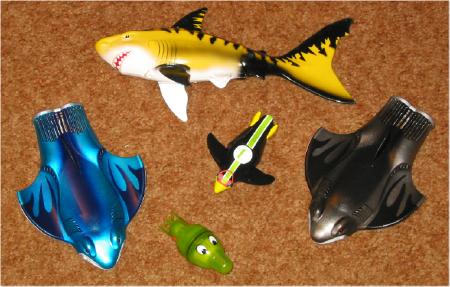
PVC pipe is a fantastic material for divers. Over the years I have accumulated a number of pipe puzzles of various sizes ranging from 18" to 10' (0.5 to 3 m) in length. They are all stored in goody bags equipped with wrist lanyards. On each goody bag, I have a small business card sized piece of plastic with a drawing of the shape the pipe pieces will form when properly assembled. Although more expensive, using male/female joints, instead of pressed fittings, gives more strength to the puzzle. This is critical for the larger puzzles, specially when used in open water. The arrangement of male/female joints on the pieces can be used to define the shape, as well as to add another element to the problem solving required to assemble the puzzle. Finally, in open water, there is an added component for the buddy team assembling the puzzle to maintain constant depth as they assemble the puzzle.
All PVC pipe parts are sold separately, so each connector must be individually assembled using the joint piece and the appropriate male/female connector. They are secured in place with PVC cement. (This cement is based on a volatile chloro-hydrocarbon and should not be inhaled. It is best to assemble the puzzles is a well-ventilated area.)
I am listing the puzzles by their sold-in-USA inside diameter. I am only listing approximate finished sizes, since the pipe can be cut to suit individual needs and space. Besides, it is the joint arrangement that primarily defines the puzzle shape.
The puzzles are listed in the approximate order of class use..
Students should be cautioned against over-tightening. An over-tightened puzzle is difficult to disassemble and often results in breaking the joint.
I only use puzzles of 2" or more inside diameter in advanced/specialty open water training. This is to facilitate handling with gloves in our colder Northern waters.
In pool training, students are allowed to use the pool bottom to assist in their problem solving. In open water, students should attempt to maintain a constant depth with control of all the pieces during assembly. Maintaining a constant depth is often difficult, especially with the larger puzzles and serves as a great example of task loading (Most students will focus on solving the puzzle without losing any puzzle components and as such, will "forget" to monitor depth.)
1/2 Inch PVC
The Small "Window"
This is the first PVC puzzle I use in class. I have 5 of them scattered along the bottom of the pool. They should not be placed near a pool drain as some of the parts are small enough to pass through the pool filter external grate. This simple puzzle serves as an introduction to future problem solving using PVC pipe puzzles. This has a solved size of about 6" x 18". (15 x 45 cm)
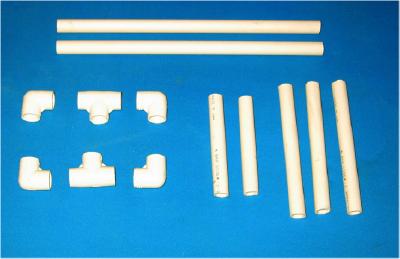 |
 |
|
The Pieces |
The Solved Puzzle |
1.5 Inch PVC Pipe Puzzles-Stored in Red Goody Bags
The "standard" US red goody bag allows a maximum length of each piece of about 12". (30 cm)
The "H"
The "H" is probably the most often used PVC pipe puzzle configuration. All joints on the "T" connector are female. Note that only the center piece has a male connector on both ends. This adds a small bit of problem solving since only one piece will complete the "H". The completed puzzle has a size of approximately 22" (56 cm) across the H center bar and a total arm length of about 26" (66 cm).
 |
 |
|
The Pieces |
The Solved Puzzle |
The "TY"
This is a one-sided extension of the "H". All joint connector pieces are female. Note that two of the straight pieces are slightly different .... they define the final shape as the four "arms" have only one joint and merely screw into their reciprocal fitting. This assembled puzzle has a width (at the far left end of illustration, below right) of 28" (71 cm) and a length of 42 " (106 cm).
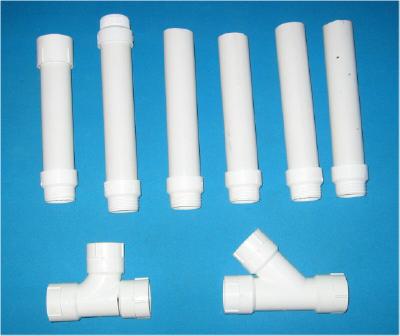 |
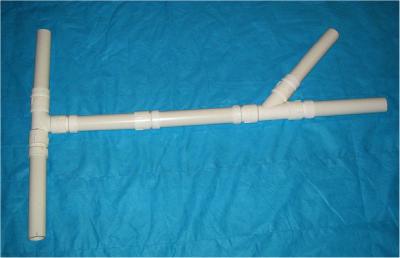 |
|
The Pieces |
The Solved Puzzle |
1.5 Inch PVC Pipe Puzzles-Stored in Yellow Goody Bags
The " standard" US yellow goody bag allows a maximum length of each piece of about 24" (61 cm)
The "Ray-Gun"
This puzzle assembles to about 4 feet (1.2 m) in length.
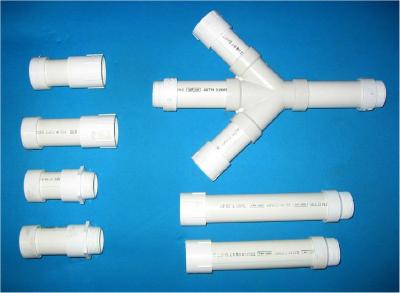 |
 |
|
The Pieces |
The Solved Puzzle |
The "Roped Y"
Each "Y" joint has two connectors and a pressed fitting. The roped pieces contain one pipe piece with a connector and one pipe piece that has no connector. The rope is eye-spliced through holes drilled in the straight pieces. Solution of the puzzle requires the rope to be in the position shown before the slack allows the piece with no fitting to be pressed into the appropriate connector. The assembled puzzle is just over 4' (1.2 m) in length.
|
|
 |
|
The Pieces |
The Solved Puzzle |
2 Inch PVC Pipe Puzzles-Stored in Yellow Goody Bags
The Rectangle
This is a simple pressed fitting rectangle. The assembled puzzle measures about 18" x 42" (46 x 107 cm).
|
|
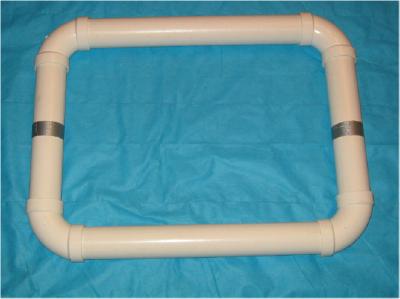 |
|
The Pieces |
The Solved Puzzle |
The "X"
The "X" has an assembled length of about 54" (138 cm ) per span.
|
|
|
|
The Pieces |
The Solved Puzzle |
The "H"
This is identical, except for size, to the 1.5" "H" puzzle. This completed puzzle has a size of approximately 28" (71 cm) : across the H center bar and a total arm length of about 60". (150 cm)
|
|
|
|
The Pieces |
The Solved Puzzle |
The "Shower T"
The completed puzzle has a size of approximately 50" (127 cm) for the middle shaft and a "top piece" length of approximately 52" (132 cm).
|
|
|
|
The Pieces |
The Solved Puzzle |
2-Inch PVC Pipe Puzzles-Stored In Green Goody Bags
The " standard" US green goody bag allows a maximum length of each piece of about 30" (76 cm).
The Large "Window"
This is one of my favorites. The large size (30" x 60"; 76 x 127 cm ) coupled with the mixture of connector styles makes for an interesting challenge. Note that three of the four corner pieces are permanently glued. This is to minimize parts loss in open water. The fourth corner piece needs to be free to facilitate closure of the desired shape.
|
|
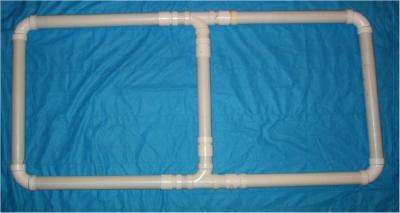 |
|
The Pieces |
The Solved Puzzle |
4-Inch PVC Pipe Puzzles-Stored In Green Goody Bags
These puzzles are large, heavy and expensive. Their bulk adds another dimension to the problem solving.
The "Fiddler Crab H"
This is another "H" with a twist ... it is a bit bulky (14 pounds; 6.4 kg ), The assembled size is 47" (119 cm) high with a cross piece length of about 38" (97 cm).
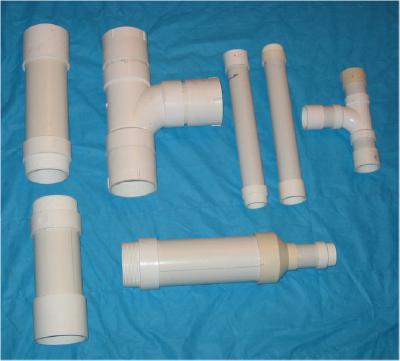 |
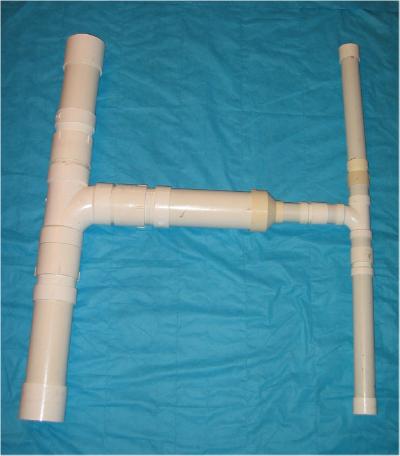 |
|
The Pieces |
The Solved Puzzle |
The "Double T"
There is no subtlety here, this is just plain huge. It weighs about 15 pounds (6.8 kg) and measures 45" x 124".(114 x 315 cm).
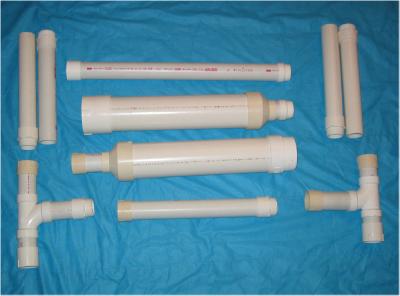 |
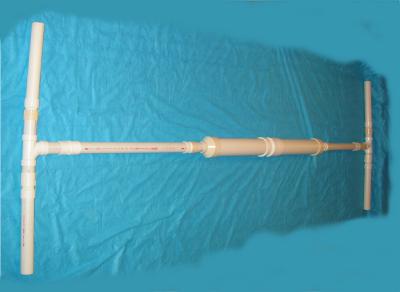 |
|
The Pieces |
The Solved Puzzle |
Conclusion
Captain James T. Kirk (Star Trek , Original Series: episode Shore Leave) once stated, "The more complex the mind, the greater the need to play." Child psychologists are now emphasizing the need to play as a necessary component of development. Playing gives students an opportunity to explore newly developed skills in a non-threatening manner that reinforces the well-known universal truth that "diving is fun!"
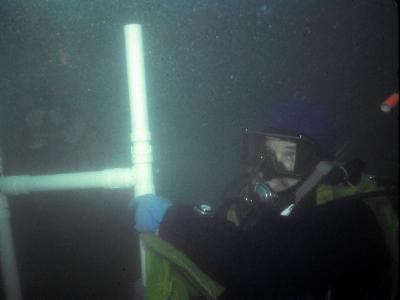 |
|
Finished Two Decades Ago ... Still Remembered |
Jump To: Treading Object Retrieval Sonic Search Golf balls The Rocket Black Mask Board Games
Mirror Tower Nuts & Bolts Hula-Hoops Pirate-Hoops Lift Bags Talking Cannon
PVC Pipe Puzzle Type: Half-inch 1.5" (Red) 1.5" (yellow) 2" (yellow) 2" (green) 4" (green)
Go To: Home About "Harris" Articles Slides War Stories Editorials Links Fini
About the Author:
Larry "Harris" Taylor, Ph.D. is a biochemist and Diving Safety Coordinator at the University of Michigan. He has authored more than
200 scuba related articles. His personal dive library (See Alert Diver, Mar/Apr. 1997, p. 54) is considered by one of the best sources of information in North America.
All rights reserved
Use of these articles for personal or organizational profit is specifically denied.
These articles may be used for not-for-profit diving education